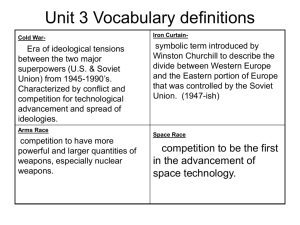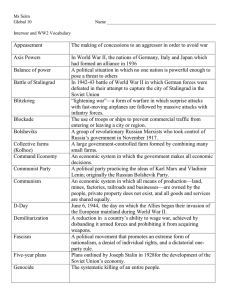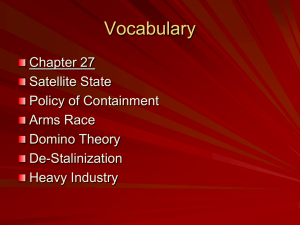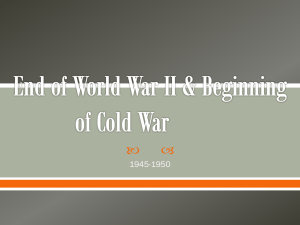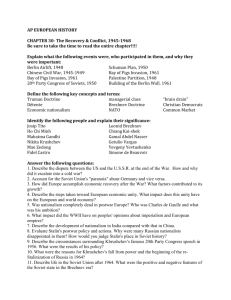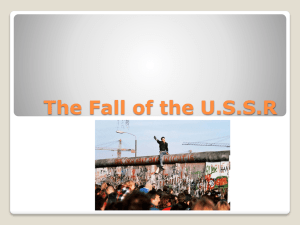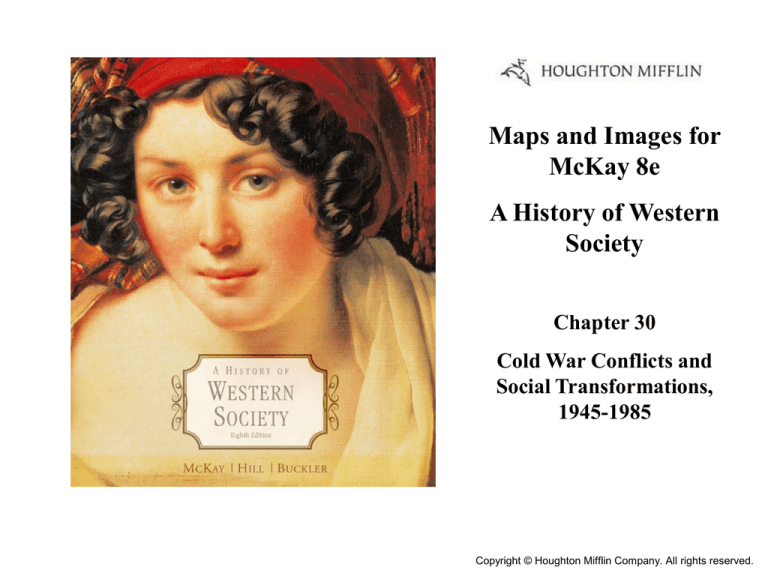
Cover Slide
Maps and Images for
McKay 8e
A History of Western
Society
Chapter 30
Cold War Conflicts and
Social Transformations,
1945-1985
Copyright © Houghton Mifflin Company. All rights reserved.
The origins of the cold war (1942—1953)
• The origins of the cold war
– The Allied decision to postpone political questions such as
the makeup of postwar Europe strengthened the Soviets.
– At Teheran (1943) the post war world was shaped
– The Big Three decision (American-British invasion) via
France meant that American-British and Russian troops
would meet along a north-south line in Germany, and only
Soviet Russia would liberate Eastern Europe. This would
split Germany between East and West.
– At the Yalta Conference (1945) the Allies decided to divide
a split Germany into national occupation zones.
• It was agreed that Germany would pay heavy reparations to
Russia.
• Stalin agreed to declare war on Japan after Germany was defeated
and to join the United Nations.
The origins of the cold war (1942—1953)
• The origins of the cold war
– The Yalta Compromise over Eastern Europe
broke down almost immediately.
– At the Potsdam Conference (1945) Truman
demanded free elections throughout Eastern
Europe, but Stalin refused. With the Red Army in
control, Stalin won.
• Stalin believed that only one party communist states
could be loyal allies.
• He feared that free elections would result in possibly
hostile governments on his western border.
– Short of war, the Western Allies could not really
influence developments in eastern Europe.
Big Three at Yalta
Big Three at Yalta
With victory over Nazi Germany assured, the leaders of the Soviet Union, Britain, and the
United States (Stalin, Winston Churchill, and Franklin D. Roosevelt) were in reasonable
spirits (though Roosevelt was ailing) when they met at Yalta, a Black Sea resort in the
Soviet Union, in February 1945. Important sources of friction among them were evident at
the meeting, but the differences that led to the Cold War did not seem paramount at this
point. The Yalta conference proved to be the last meeting of the three leaders.
West versus East
• Truman cut off aid to Russia because of Stalin’s
insistence on having communist governments in
Eastern Europe.
• By 1947, many Americans believed that Stalin was
trying to export communist revolution throughout
Europe and the world.
• The Marshall Plan was established to help European
economic recovery; the Truman Doctrine was meant to
ward off communist subversion with military aid. The
Truman Doctrine was designed to contain the spread of
Communism, not defeat it.
• The Soviet blockade of Berlin led to a successful Allied
airlift.
West versus East
• Truman cut off aid to Russia because of Stalin’s
insistence on having communist governments in
Eastern Europe.
• By 1947, many Americans believed that Stalin was
trying to export communist revolution throughout
Europe and the world.
• The Truman Doctrine of 1947
– US must contain communism to areas where the Red
Army occupied
– US must help non-communist nations resist
– Resistance both internally and externally
– Begins with Greece Civil War & Turkey
– Initially financial aid, later troops if needed
Map: Military Alliances and Multinational Economic Groupings, 1949-1989
Military Alliances and Multinational Economic Groupings, 1949-1989
The cold war split was reflected especially in the two military alliances: NATO, formed in
1949, and the Warsaw Pact, formed in 1955. Each side also had its own multinational
economic organization, but the membership of the EEC, or Common Market, was not
identical to that of NATO. Although communist, Yugoslavia remained outside Soviet-led
organizations, as did Albania for part of the period.
West versus East
• The USSR returned to pre WW II Totalitarianism
• In 1949, the United States in response to the Czech
communists coup and the Berlin Blockade, formed an
anti-Soviet military alliance of Western governments,
the North Atlantic Treaty Organization (NATO); in
return, Stalin united his satellites in the Warsaw Pact.
• In 1949, communists won in China.
• In 1950, when communist North Korea invaded the
south, American-led UN troops intervened.
• The Western attempt to check Stalin probably came
too late and may have encouraged Russian aggression.
The western renaissance
• The postwar challenge
– The war left Europe physically devastated and in a state of economic
and moral crisis.
• Food rationing was necessary.
• Russia’s border had been pushed west, as was Poland’s; thus,
many Germans were forced to resettle in a greatly reduced
Germany.
– All the Allies treated Germany harshly.
– New leaders and new parties, especially the Catholic Christian
Democrats, emerged in Italy, France, and Germany and provided
effective leadership and needed reforms. Leaders such as de
Gaspari, Schuman, and Adenauer exemplified these parties.
– In many countries, such as Britain, France, and Italy, socialists and
communists emerged from the war with considerable power and a
strong desire for social reform.
– The Marshall Plan aided in economic recovery and led to the
Organization for European Economic Cooperation (OEEC);
military protection was provided through NATO.
Map: The Impact of World War II in Europe
The Impact of World War II in Europe
As a result of World War II the Soviet Union expanded its western borders and Poland shifted westward at the
expense of Germany. Territorial changes added to the wartime disruption and produced a flood of refugees. The cold
war division of Europe did not depend on immediate territorial changes, but soon Germany itself came to be divided
along east-west lines. (Copyright (c) Houghton Mifflin. All rights reserved.)
The western renaissance
• Economic miracles
– Led by West Germany, a European economic miracle was
underway by 1963.
• American aid helped get the process off to a fast start.
• European nations coordinated the distribution of American aid, so
barriers to European trade and cooperation were quickly dropped.
– A free-market economy with a social welfare network
brought rapid growth to Germany. Ludwig Erhard
fostered this free market capitalism.
– Flexible planning and a mixed state and private economy
brought rapid growth to France.
– A skilled labor pool, new markets for consumer products,
and the Common Market stimulated economic
development in Western Europe.
The western renaissance
• Toward European unity
– Democratic republics were re-established in France, West Germany,
and Italy.
– The Christian Democrats were committed to a unified Europe, but
economic unity proved to be more realistic than political unity.
– The six-nation Coal and Steel Community marked the beginning of a
movement toward European unity and led to further technical and
economic cooperation.
– The Treaty of Rome (1957) created the European Economic
Community (EEC, or Common Market), whose immediate goal was to
create a free-trade area by reducing tariffs. Robert Schuman’s plan
was designed to bind countries so close as to make war impossible in
the future.
– However, regenerated hopes for political union in Europe were
frustrated by a resurgence of nationalism in the 1960s.
• De Gaulle, a romantic nationalist, wanted France to lead the Common
Market.
• He withdrew from NATO and vetoed British attempts to join the Common
Market.
Decolonization
• The causes of imperial decline
– Nationalism brought demands for political selfdetermination in colonial areas after the First
World War.
• The Second World War reduced European
power and destroyed the Western sense of
moral superiority.
• The USSR began to undermine Colonial
governments by supporting independence
movements.
Map: Decolonization, 1945-1980
Decolonization, 1945-1980
During a thirty-five-year period after World War II, the European empires in
Africa, Asia, and the Pacific gradually came apart as the former colonies became
independent nations. (Copyright (c) Houghton Mifflin. All rights reserved.)
Nationalism in India and China
• Gandhi led the Indian nationalist movement, and
India won limited self-government in 1937. He based
his strategy on nonviolent cooperation.
– Britain granted independence after the Second World War
by creating a Hindu state of India and a Muslim state of
Pakistan.
– After a bitter civil war, the Communists forced the
Nationalists out of China to the island of Taiwan in 1949.
Mao won due to support from peasants because of land
reform promises.
– Mao Zedong began building a communist society along
Soviet lines, with collectivization of the peasants and fiveyear plans concentrating on heavy industry.
– The French were defeated in Indochina by Ho Chi Minh,
and Vietnam was divided into two zones pending
unification on the basis of free elections.
Arab nationalism and African independence
• Arab nationalism challenged imperial power and the new Jewish nation.
• A Jewish state was created out of part of British-controlled Palestine
(1948) when Palestine was partitioned and was attacked by the Arab
countries, which were defeated.
• Palestinian refugees refused to accept defeat and vowed to continue
fighting to destroy the Jewish state of Israel.
• Successful nationalist revolution took place in Egypt (1952), and the new
leader, Nasser, nationalized the Suez Canal. This provoked a British
French invasion.
• Arab nationalists in Algeria fought for and won independence from
France 1962.
• In most of the rest of Africa, independence was achieved without war,
although many new African countries remained dependent on France and
the Common Market. This enhanced cultural and economic ties with
former colonies.
• Overall, western European countries actually increased their economic
and cultural ties with their former African colonies in the 1960s and
1970s—some historians call this “neo-colonialism.”
Map: The Proposed Partition of Palestine and the Birth of the State of Israel
The Proposed Partition of
Palestine and the Birth of
the State of Israel
In November 1947 the
United Nations offered a
plan to partition the British
mandate of Palestine, but
complications immediately
arose. The Jews of the area
won their own state, Israel,
but the Palestinian Arabs
did not. Thus tensions
continued in the area.
Saudi riches
Saudi riches
Enormous oil reserves make Saudi Arabia one of the most influential members of
the Organization of Petroleum Exporting Countries (OPEC) and give it one of the
world's highest per capita incomes. Oil has also made rich men of Prince Fahd and
King Khalid, shown here considering plans for a new urban development.
Oil crisis at gas station
Oil crisis at gas station
Dislocations in the oil industry caused by OPEC (Organization of
Petroleum Exporting Countries) price rises that began in 1974
produced long lines at the gas pump and local shortages. The crisis
brought Middle East politics home to consumers and created a
negative stereotype of oil sheikhs. (Keza/Liaison/Getty Images)
Soviet Eastern Europe
• While the West surged ahead economically, Eastern Europe’s
political, economic, and social developments were slow and
uneven—nearly at a halt by the 1960s. The USSR returned to
the totalitarianism of the 1930’s.
• Stalin’s last years
– The national unity of the war period ended in rigid dictatorship again.
– Stalin began a new series of purges and enforced cultural conformity.
– Soviet citizens living outside Russia were forced to return, and nearly a million of
them, plus other Russians, died in labor camps.
– Culture, art, and the Jewish religion were attacked.
• Five-year plans were reintroduced; heavy and military
industries were given top priority, while consumer goods,
housing, and agriculture were neglected.
• Stalin’s system was exported to Eastern Europe.
– Only Tito in Yugoslavia was able to build an eastern European communist
state free from Stalinist control.
– Tito’s success led Stalin to purge the Communist parties of Eastern
Europe in an attempt to increase their obedience to him.
Soviet Eastern Europe
• Reform and de-Stalinization
– Khrushchev and fellow reformers won the leadership of Russia over
the conservatives, who wanted to make as few changes as possible in
the Stalinist system. Reformers wanted reform in agriculture and
consumer sectors, to end the diplomatic isolation of the USSR and to
end the internal fear and hatred caused by Stalin.
– Khrushchev denounced Stalin at the Twentieth Party Congress in 1956
and began a policy of liberalization.
• The Soviet standard of living was improved, and greater intellectual
freedom was allowed, this led to rebelliousness among intellectuals and
Eastern European Countries.
• Nevertheless, Pasternak was not allowed to accept the Nobel Prize in 1958
for Doctor Zhivago.
• Solzhenitsyn’s book on life in a Stalinist camp, One Day in the Life of Ivan
Denisovich, caused an uproar when it was published in Russia in 1962.
• Khrushchev pushed for “peaceful coexistence” with the West and a
relaxation of cold war tensions.
– De-Stalinization caused revolution in Eastern Europe in 1956.
• Poland under Gomulka won greater autonomy.
• Hungary expelled Soviet troops in 1956 and declared its neutrality but was
invaded by Russia and defeated.
Confrontation, Nixon/Khrushchev
Confrontation, Nixon/Khrushchev
U.S. vice president Richard M. Nixon and Soviet premier
Nikita Khrushshev had a heated exchange of views during
Nixon's visit to a Moscow trade fair in 1959. Two years earlier,
the Soviet Union had launched the world's first space satellite.
Hungarian Revolution 1956
Hungarian Revolution 1956
By mid-1956 the Hungarian Imre
Nagy (1896-1958) had taken
advantage of the liberalizing
atmosphere to begin dismantling
collective farms and to move
toward a multi-party political
system in Hungary. The Soviets
used tanks to crush the Hungarian
reform movement. Thousands of
Hungarians were killed during the
fighting or subsequently executed,
and 200,000 Hungarians fled to
the west. Here we see members of
the insurrection destroying Soviet
propaganda material and
portraits of Stalin, in
Koeztarsasag Square, Budapest.
(Erich Lessing/Magnum Photos)
Soviet Eastern Europe
• The fall of Khrushchev
– Re-Stalinization began with Khrushchev’s fall
(1964).
– Khrushchev’s policy of de-Stalinization was
opposed by conservatives, who saw it as a threat to
themselves and the whole communist system.
– Khrushchev’s erratic foreign policy was also an
issue—he was successful in building the Berlin wall
but was forced to back down on the installation of
missiles in Cuba.
– Brezhnev, who took over in 1964, stressed the ties
with the Stalinist era and launched an arms
buildup.
Cuban Crisis: JFK in meeting
Cuban Crisis: JFK in meeting
The October 29 meeting of the "ExComm," or Executive Committee (the only meeting
photographed). To President Kennedy's immediate right is Secretary of State Dean Rusk;
to his left (in front of the Presidential Seal on the wall) is Secretary of Defense Robert
McNamara. Presidential adviser Theodore Sorensen (on near side, third from right) later
wrote: "I saw first-hand how brutally physical and mental fatigue can numb the good sense
as well as the senses of normally articulate men." (Kennedy Library)
Life in the postwar era
• Science and technology
– The Second World War’s focus on military problems brought them
together.
– The results have been both good and bad.
• New industries were created, and rapid economic growth was achieved
after 1945.
• The environment was adversely affected by technological change.
• Second World War
– With the Second World War, pure science lost its independence as
leading scientists worked for their governments to help fight the war.
– The war led to major technological breakthroughs, such as radar,
improved jet engines, computers, and the atomic bomb.
• Einstein’s letter to Roosevelt in 1939 about the theoretical possibility of the
atomic bomb led to the Manhattan Project.
• The first atomic bomb was successfully tested in July 1945.
Ban the Bomb and Bertrand Russell
Ban the Bomb and Bertrand Russell
As nuclear tension escalated during the 1950s, some built air-raid shelters; others
took to the streets in antinuclear protests. The Ban-the-Bomb movement was
especially prominent in Britain, where the noted philosopher Bertrand Russell
(1877-1970) played a central role. Here, seated at right, he awaits arrest during a
sit-in demonstration outside the British Defense Ministry.
Life in the postwar era
• Big Science
– Big Science could attack difficult problems by combining theoretical
work with engineering techniques.
– Big Science needed a great deal of money, mostly for its complex
equipment, which it received from government and large
corporations.
• The European nations pooled their resources in CERN to build an
accelerator.
• Astronomical and aeronautical research also became very costly.
– The United States took the lead in Big Science after the Second World
War.
• By 1965, most of the funds for scientific research came from the
government.
• A large portion of scientific research was devoted to defense.
– Russia pioneered in the development of a space program by launching
a satellite in 1957, but the United States put the first men on the
moon, in 1969.
– European countries undertook financing of Big Science in order to
stop the “brain drain” of their best scientists to the United States.
Life in the postwar era
• The lives of scientists
– There were many more scientists and much
specialized knowledge.
– Specialization made teamwork, bureaucracy,
and managers necessary.
– It became difficult to appraise an individual
scientist’s contribution to a team effort.
– Competition among scientists was often fierce.
Sartre and de Beauvoir, late 1940s
Sartre and de Beauvoir, late 1940s
Among the most influential intellectual couples of the century, JeanPaul Sartre and Simone de Beauvoir emerged as leaders of French
existentialism by the later 1940s. (Giansanti/Corbis Sygma)
Life in the postwar era
• Class structure and social reform
– Because of rapid economic growth and scientific progress, after 1945 the traditional
class distinctions became less clear-cut, and society became more mobile and
democratic.
– Educational and employment opportunities made the middle class more open. The
growth of the middle class was based on the demand for technologists and mangers.
• Talent and expertise became more important to success than inherited property or family
connections.
• The middle class grew greatly as entry became easier.
• The lower class featured a rapid growth in white collar and service jobs.
– The rural working class shrank in size due to the mass exodus from the country.
– Social security reforms and rising affluence
• Social security reforms like health care and family allowances reduced class tensions.
Higher taxes on the rich also helped in the leveling of European Society.
• These reforms promoted greater social and economic equality.
• Lower food costs allowed for greater consumption of other goods.
• Greater consumption was accompanied by the problem of overeating, diet fads, and junk
food.
• Automobile ownership increased; gadgets and household appliances, largely bought on
credit, became necessities for most families.
• Most European countries provided health care, public housing, family allowances and
maternity grants.
– Leisure and recreation, especially travel, became big business.
Chicago, Dinner Party
Chicago, Dinner Party
The Dinner Party--the multimedia creation of Judy Chicago (American installation artist,
b. 1939)--features thirty-nine handcrafted placemats and ceramic plates, each embellished
with a painted motif associated with the woman being honored. Begun in 1974 and
completed in 1978, with the participation of more than one hundred women, Chicago
wanted to represent the historic struggle of women to participate in all the aspects of
society. It attracted enormous crowds.
Italian feminists
Italian feminists
These Italian feminists
demonstrate in Rome in
1981 for the passage of
legislation legalizing
abortion, which the pope
and the Catholic church
have steadfastly
opposed. This woman's
provocative sign says
that she does not want
the pope in her bed.
(Giansanti/Corbis
Sygma)
Life in the postwar era
• Youth and the counter-culture
– Prosperity and increased democracy in the 1960s led to a youth culture,
which rebelled against authority and the status quo. This grew out of
mass communication, travel, post war prosperity and the baby boom.
– In America, the youth rebellion grew out of the “beat” generation of the
1950s, and then became a major culture in the 1960s—much of it
beginning in San Francisco and Chicago’s Near North.
• Rock music and drugs encouraged its popularity; rock poet-singer Bob
Dylan best expressed the movement’s radical politics.
• Sexual behavior changed; sexual intercourse between non-married young
people increased dramatically.
– The international aspect of this culture was encouraged by modern mass
transportation, by the large proportion of young people in society (the
baby boomers), and by greater youth purchasing power.
– Youth culture was in opposition to the established order because of
feelings of generational conflict, the rebirth of romanticism and
revolutionary idealism—including the idea that the West was hopelessly
rotten. They became bored with prosperity and felt disenfranchised
with the materialistic West.
• As a result, the Vietnam War took on great significance—as young people
concluded that the war was immoral.
Youth revolution, London, 1980
Youth revolution,
London, 1980
A wonderful photograph
of colorfully--and
outrageously--dressed
youth in London (ca.
1980), during what was
called the youth
revolution. (Anthea
Sieveking/The Wellcome
Trust Medical
Photographic Library)
Antiwar rally
Antiwar rally
Divisions over the Vietnam
War ran deep in the United
States. Antiwar protesters
captured the public's
attention, but anti-Vietcong
demonstrations like this one
spoke for many Americans.
Opinion polls showed that
fewer than 20 percent of
Americans supported
withdrawal from Vietnam
until after the November
1968 elections, by which
time the decision to get out
had been made. (Burt
Glinn/Magnum Photos)
Life in the postwar era
• Upheaval in the late 1960s
– American involvement in Vietnam grew out of its efforts to contain
communism.
– The U.S. refused to sign the Geneva Accords that divided Vietnam and
guaranteed free elections, and it started providing military aid to South
Vietnam.
– President Johnson vowed not to “lose” Vietnam and therefore carried out a
massive military buildup and bombing, but without achieving victory. The
Tet Offensive in 1968 became a great psychological victory for North
Vietnam.
– Criticism of the war brought the political downfall of Johnson and the 1968
election of President Nixon.
• A major Democratic candidate was Robert Kennedy, but he was assassinated;
the nomination went to Hubert Humphrey, Johnson’s vice president.
– Nixon cut war costs and brought many troops home, but the war continued
for another four years. Nixon did end the Vietnam War. He suspended the
draft, reduced operations such as search and destroy and pursued peace
negotiations with the North.
– Nixon journeyed to China in 1972 and reached a limited reconciliation with
its communist government.
• A peace agreement with North Vietnam was signed in 1973, and the American
forces completed their withdrawal.
Vietnam Veterans' Memorial
Vietnam Veterans' Memorial
The Vietnam Veterans Memorial in Constitution Gardens, Washington D.C.,
designed by Maya Ying Lin (American, b. 1960) is perhaps the consummate
minimalist sculpture. The memorial consists of two walls of black granite, each
nearly 250 feet long, which meet at a 136-degree angle at the center, where they are
10 feet tall. The names of the nearly 58,000 dead are inscribed on the wall,
beginning with the first in 1959 and ending with the final death in 1975.
Life in the postwar era
• Europe and the student revolution in France
– Many of the younger generation claimed that increasing materialism was
harmful and that postwar society was repressive and flawed.
– Prior to the 1950s, higher education in Europe has been limited to only a
few.
– However, the number of people entering European universities increased
in the 1950s and 1960s.
• Overcrowding resulted, and a new “youth culture” emerged.
• Many students believed they were not getting the kind of education they
needed. They criticized Western Society as the reason.
– With help from workers, student revolts over these issues occurred in the
late 1960s and early 1970s.
• In 1968, student radicals appealed to workers and a general strike spread
across France. These students almost toppled de Gaulle’s fifth Republic.
• De Gaulle moved troops toward Paris and called for new elections, which he
won resoundingly.
– The student rebellion reflected disillusionment with materialism,
technological society, and the Vietnam War.
Student Rebellion, Paris
Student Rebellion, Paris
These rock-throwing students in the Latin Quarter of Paris are trying to force education
reforms and even to topple de Gaulle's government. Throughout May 1968 students
clashed repeatedly with France's tough riot police in bloody street fighting. De Gaulle
remained in power, but a major reform of French education did follow.
The Beatles
The Beatles
The older generation
often saw sexual license
and immorality in the
Beatles' frank lyrics and
suggestive style. But in
comparison with all that
came after them in the
world of pop music, the
Beatles were sentimental
and wholesome. (John
Zimmerman/Camera
Press/Retna Ltd.)
Life in the postwar era
• Reform in Czechoslovakia
– Under the reformer Dubcek, the Czech Communist party instituted
reforms that stressed socialism with freedom and party democracy. They
attempted to make communism more humane and reasonable.
• The reforms were popular but frightened entrenched powers.
• The Soviets feared Czech neutralism or even a pro-Western policy.
– The Soviets responded in August 1968 by occupying Czechoslovakia.
• The Czech reforms were abandoned.
• The Brezhnev Doctrine was declared, giving the Soviet Union the
right to intervene in any socialist country whenever it saw the
need.
• The West and the USA did not respond because of the Truman
Doctrine and Czechoslovakia was considered to be part of the
Soviet Sphere of Influence.
1968 Invasion of Czechoslovakia
1968 Invasion of Czechoslovakia
Soviet leaders moved tanks into Prague in August 1968, and ended the widely admired
reform movement taking place in Czechoslovakia. Though there were protests, as shown
here on August 20, the outcome was a foregone conclusion once the Soviets decided to
intervene. Although life soon returned to normal in the Czechoslovak capital, the ending of
the Prague Spring proved a watershed for the fate of communism in Europe.
Women's work in the Soviet Union
Women's work in the
Soviet Union
This cartoon adapts the
caryatid form from
ancient sculpture to
depict the special
burdens that were
coming to bear more
heavily on women as
the Soviet economy
bogged down. Intended
to commemorate
International Women's
Day, the image
appeared in the Soviet
magazine Krokodil in
1984.
1960s
• NATO and Warsaw Pact
• Arms buildup
• Berlin Wall built
• Cuban missile crisis
• Vietnam War
• Breschnev Doctrine
The Cold War:
Freeze to Thaw
1990s
• Collapse of Soviet Union
• German reunification
• Expansion of UN peacekeeping
• Ethnic conflicts in Eastern
Europe
• Move toward market economy
in Russia
• Economic distress in former
Soviet Union
1970s
• Détente
• Reduction of nuclear arsenals
• Aid to developing countries
• Soviet invasion of Afghanistan
• U.S. withdrawal from Vietnam
1980s
• Economic decline of Soviet
Union
• Gorbachev's glasnost and
perestroika
• Berlin Wall torn down
• Soviet withdrawal from
Afghanistan
• Move toward democracy in
Eastern Europe


